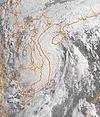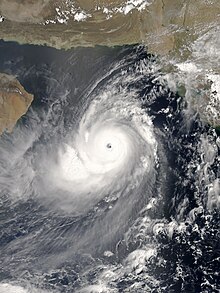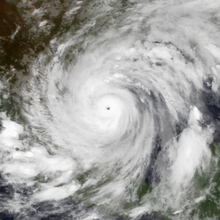Portal:Tropical cyclones
The Tropical Cyclones Portal

A tropical cyclone is a storm system characterized by a large low-pressure center, a closed low-level circulation and a spiral arrangement of numerous thunderstorms that produce strong winds and heavy rainfall. Tropical cyclones feed on the heat released when moist air rises, resulting in condensation of water vapor contained in the moist air. They are fueled by a different heat mechanism than other cyclonic windstorms such as Nor'easters, European windstorms and polar lows, leading to their classification as "warm core" storm systems. Most tropical cyclones originate in the doldrums, approximately ten degrees from the Equator.
The term "tropical" refers to both the geographic origin of these systems, which form almost exclusively in tropical regions of the globe, as well as to their formation in maritime tropical air masses. The term "cyclone" refers to such storms' cyclonic nature, with anticlockwise rotation in the Northern Hemisphere and clockwise rotation in the Southern Hemisphere. Depending on its location and intensity, a tropical cyclone may be referred to by names such as "hurricane", "typhoon", "tropical storm", "cyclonic storm", "tropical depression" or simply "cyclone".
Types of cyclone: 1. A "Typhoon" is a tropical cyclone located in the North-west Pacific Ocean which has the most cyclonic activity and storms occur year-round. 2. A "Hurricane" is also a tropical cyclone located at the North Atlantic Ocean or North-east Pacific Ocean which have an average storm activity and storms typically form between May 15 and November 30. 3. A "Cyclone" is a tropical cyclone that occurs in the South Pacific and Indian Oceans.
Selected named cyclone -
Hurricane Alex was the first tropical cyclone of the 2010 Atlantic hurricane season, and a rare June Atlantic hurricane. Originating from an area of disturbed weather on June 25, 2010, it slowly developed in the western Caribbean Sea and struck Belize as a strong tropical storm. After entering the Gulf of Mexico, Alex became very large and encountered conditions favorable for gradual development. Early on June 30, the cyclone attained hurricane status as it approached northeastern Mexico, the first June hurricane in the Atlantic basin since Hurricane Allison in 1995, and the storm rapidly intensified just off the coast of Tamaulipas. Alex made landfall near Soto la Marina as a Category 2 hurricane on the Saffir-Simpson Hurricane Wind Scale. Alex rapidly weakened after landfall, with the storm losing its tropical status on July 2, before fully dissipating on July 6.
Alex caused the deaths of at least 51 people along its path, and produced over $1.5 billion (2010 USD) in damage. The precursor of the hurricane produced substantial rainfall across the Greater Antilles, causing one death in the Dominican Republic. Fourteen people were killed in Central America as a result of flooding during the first landfall of Alex. In Mexico, the storm's outer rainbands killed three people in Acapulco, one person in Oaxaca, and another in Chiapas. At its final landfall, Alex caused at least fifteen deaths in Nuevo León, eight in Coahuila, six in Guanajuato, and one in both Tamaulipas and San Luis Potosí; an additional twenty persons were reported missing. (Full article...)Selected article -
Tropical cyclones and subtropical cyclones are named by various warning centers to simplify communication between forecasters and the general public regarding forecasts, watches and warnings. The names are intended to reduce confusion in the event of concurrent storms in the same basin. Once storms develop sustained wind speeds of more than 33 knots (61 km/h; 38 mph), names are generally assigned to them from predetermined lists, depending on the basin in which they originate. Some tropical depressions are named in the Western Pacific, while tropical cyclones must contain a significant amount of gale-force winds before they are named in the Southern Hemisphere.
Before it became standard practice to give personal (first) names to tropical cyclones, they were named after places, objects, or the saints' feast days on which they occurred. Credit for the first usage of personal names for weather systems is generally given to Queensland Government Meteorologist Clement Wragge, who named systems between 1887 and 1907. When Wragge retired, the practice fell into disuse for several years until it was revived in the latter part of World War II for the Western Pacific. Formal naming schemes and lists have subsequently been used for major storms in the Eastern, Central, Western and Southern Pacific basins, and the Australian region, Atlantic Ocean and Indian Ocean. (Full article...)Selected image -

Selected season -

The 1933 Atlantic hurricane season is the most active Atlantic hurricane season on record in terms of accumulated Cyclone Energy (ACE), with a total of 259. It also set a record for nameable tropical storms in a single season, 20, which stood until 2005, when there were 28 storms. The season ran for six months of 1933, with tropical cyclone development occurring as early as May and as late as November. A system was active for all but 13 days from June 28 to October 7.
Because technologies such as Earth observation satellites were not available until the 1960s, historical data on tropical cyclones from the early 20th century is often incomplete. Tropical cyclones that did not approach populated areas or shipping lanes, especially if they were relatively weak and of short duration, may have remained undetected. Compensating for the lack of comprehensive observation and the limited technological ability to monitor all tropical cyclone activity in the Atlantic Basin during this era, research meteorologist Christopher Landsea estimates that the 1933 season may have produced an additional 2–3 missed tropical cyclones. A 2013 reanalysis of the 1933 Atlantic Hurricane Database did indeed identify two new tropical storms; however, it was also determined that two existing cyclones did not reach tropical storm intensity and so were removed from the database. Additionally, researchers found two existing storms to be one continuous system. As a result, the season storm total dropped from 21 to 20. (Full article...)Related portals
Currently active tropical cyclones

Italicized basins are unofficial.
- North Atlantic (2024)
- No active systems
- East and Central Pacific (2024)
- No active systems
- North Indian Ocean (2024)
- No active systems
- Mediterranean (2023–24)
- No active systems
- South-West Indian Ocean (2023–24)
- No active systems
- Australian region (2023–24)
- No active systems
- South Pacific (2023–24)
- No active systems
- South Atlantic (2023–24)
- No active systems
Last updated: 00:02, 23 May 2024 (UTC)
Tropical cyclone anniversaries

- May 22, 1996 - Tropical Storm Cam (pictured) reached its peak intensity with 110 km/h (70 mph) while moving to the east through the Luzon Strait between the Philippines and Taiwan.

May 23
- 1976 - Subtropical Storm One struck the Florida Panhandle, bringing heavy rainfall to the southeastern United States but only minimal damage.
- 2003 - Typhoon Chan-hom (pictured) reaches its maximum intensity as a Category 4 typhoon with a pressure of 940 mbar (27.76 inHg).

- May 24, 1989 - Tropical Storm Cecil (pictured) made landfall in central Vietnam where it killed 52 people and left over 100,000 others homeless.
Did you know…




- …that the Joint Typhoon Warning Center considers that Typhoon Vera (pictured) of 1986 is actually two distinct systems, formed from two separated low-level circulations?
- …that Hurricane Agatha (pictured) was the strongest Pacific hurricane to make landfall in Mexico in May since records began in 1949?
- …that Cyclone Raquel (track pictured) travelled between the Australian and South Pacific basins between the 2014–15 and 2015–16 seasons, spanning both seasons in both basins?
- …that Cyclone Amphan (pictured) in 2020 was the first storm to be classified as a Super Cyclonic Storm in the Bay of Bengal since 1999?
General images -

Topics
Subcategories
Related WikiProjects
WikiProject Tropical cyclones is the central point of coordination for Wikipedia's coverage of tropical cyclones. Feel free to help!
WikiProject Weather is the main center point of coordination for Wikipedia's coverage of meteorology in general, and the parent project of WikiProject Tropical cyclones. Three other branches of WikiProject Weather in particular share significant overlaps with WikiProject Tropical cyclones:
- The Non-tropical storms task force coordinates most of Wikipedia's coverage on extratropical cyclones, which tropical cyclones often transition into near the end of their lifespan.
- The Floods task force takes on the scope of flooding events all over the world, with rainfall from tropical cyclones a significant factor in many of them.
- WikiProject Severe weather documents the effects of extreme weather such as tornadoes, which landfalling tropical cyclones can produce.
Things you can do
 |
Here are some tasks awaiting attention:
|
Wikimedia
The following Wikimedia Foundation sister projects provide more on this subject:
-
Commons
Free media repository -
Wikibooks
Free textbooks and manuals -
Wikidata
Free knowledge base -
Wikinews
Free-content news -
Wikiquote
Collection of quotations -
Wikisource
Free-content library -
Wikiversity
Free learning tools -
Wikivoyage
Free travel guide -
Wiktionary
Dictionary and thesaurus























































